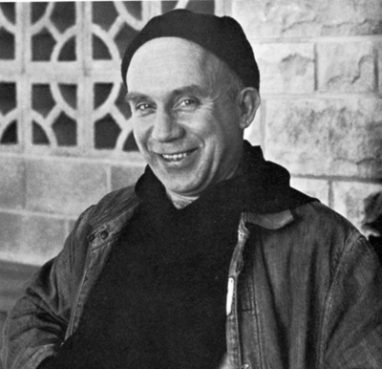
(RNS) Trappist monk Thomas Merton is considered one of the most influential spiritual writers of the 20th century. Merton died in 1968 while attending a monastic conference in Bangkok, Thailand. Religion News Service file photo used with permission of the Merton Legacy Trust and the Merton Center at Bellarmine University.
(RNS) Rarely has a romance seemed so star-crossed. He was 51, she 25. She was a pretty, petite student-nurse; he was stocky and bald, with a roving intellect and a boisterous laugh.
He was also the most celebrated Catholic monk in America.
Margie Smith had read at least one of the books that made Thomas Merton famous when she walked into his hospital room in Louisville, Ky., in 1966. Over the next several months, the nurse and the monk wrote letters, drank wine, and fell in love, sneaking in and out of the Abbey of Gethsemani like love-struck teenagers.
“There is no question I am in deep,” Merton wrote in his journal just a month after meeting M., as he coded her name. Though some Merton biographers have been reluctant to reveal Smith’s full name — and still gasp at its disclosure — it has been published in recent years in biographies and national newspapers.
The cloistered Merton burst into public view in 1948 with the publication of his memoir “The Seven Storey Mountain,” which detailed his journey from a young rogue who wallowed in “beer, bewilderment, and sorrow,” according to a friend, to a penitent novitiate in the Order of Cistercians of the Strict Observance, the formal name of the Trappist order.
Merton went on to write a steady stream of spiritual books, essays and poems, and became one of the best known and well-loved Catholic writers of the 20th century. He died at age 53 in 1968 in a freak electrocution accident in Thailand.
Scholars and even casual Mertonites have long known of his affair with Smith, especially since his seven-volume personal journals, in which he pins down passing emotions like a butterfly collector, were published in the 1990s. But some disagree about whether the affair was a regrettable interlude, or an emotional breakthrough for a man who had long struggled with his feelings toward women.
A new Merton biography, “Beneath the Mask of Holiness,” falls firmly in the latter camp. Author Mark Shaw paints a portrait of the monk as a tormented, “imposter of sorts,” who reluctantly played the part of the happy, contemplative guru. In reality, Shaw argues, Merton was haunted by his youthful indiscretions with women — including reportedly, the fathering of a child out of wedlock — and the chasm between his private past and public persona.
Merton’s mother died when he was 6 and he entered the monastery without ever having a loving relationship with a woman, according to Shaw. The affair with M., which Shaw calls a “magical, inspiring love story,” filled that need and changed his life.
“Having proved to himself that he could truly love, and be loved, Thomas Merton shed his mask, since no `unfinished business’ was present to restrict any freedom to be with `God alone,”‘ Shaw said in an interview.
After several months, however, Merton realized the relationship was untenable; he broke it off, and reaffirmed his monastic vows.
Compelling as his theory may be, a number of Merton scholars strongly disagree with Shaw’s reading of the monk’s life, calling it prurient and ill-informed. In fact, “Beneath the Mask of Holiness,” has caused a small stir in the typically placid waters of the International Thomas Merton Society.
Jim Forest, an acclaimed biographer of Merton, wrote a scathing review of Shaw’s book in the winter edition of “The Merton Seasonal,” a joint publication of the International Thomas Merton Society and the Thomas Merton Center at Bellarmine University in Kentucky.
“Unfortunately, Shaw seems to have no understanding of or sympathy with Merton’s basic choices: to become a Christian, to be baptized in the Catholic Church, and then to embrace monastic life …” Forest writes.
A number of other Merton scholars refused requests to comment on the book, saying that they have not read it and do not plan to.
Stung by the reaction, Shaw, who calls himself a “reformed” lawyer and media personality, said he has considered resigning from the Merton Society. “Stirring up so much controversy and such strong emotion was not what I expected when I wrote this book,” Shaw said in an e-mail. “But I knew the risk was there as I feared some would feel I was attacking a sacred cow …”
In an interview, Forest accused Shaw of pulling quotations from Merton’s journals out of context and using them to fit his thesis of a malcontent monk set free by a romantic affair. In fact, Merton was a cheerful man who occasionally struggled with his vocation but felt deeply committed to it, Forest said.
“People like myself who knew Merton simply won’t recognize him,” in Shaw’s book; the idea of the Catholic Church “squeezing Merton into a costume of sanctity is just nonsense,” he added.
If Merton was truly unhappy with being a “poster-boy” for Catholic contemplative life, as Shaw asserts, he could have left Gethsemani at any time, said the Rev. James Martin, an editor at the Jesuit weekly magazine America who has written several essays on Merton.
“Clearly, if he was so miserable, he would have left the monastery and taken up with Margie,” Martin said. Merton’s decision to remain a monk puts the lie to Shaw’s theory, according to Martin and others.
For sure, Merton was not the typical monk. He butted heads with superiors, received a steady stream of visitors, made a deep study of Zen Buddhism, and occasionally left the abbey to down a few bourbons. Still, Merton’s evident humanity does not make him any less holy, said Martin.
“Especially with Merton, one sees both the sins and the sanctity,” Martin said. “And I wonder if this isn’t something like the way God sees us.”




